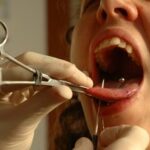Tongue piercing is a form of body art seen as one of the most painful by those who have never undergone such modification. In reality, tongue piercing is actually almost pain free. The pain associated with tongue piercing comes from improper aftercare, which may result in severe infection. If properly taken care of, a tongue piercing can be one of the easiest to endure.
Tongue piercing aftercare instructions should be vehemently followed. Our mouth is full of bacteria which will be scrambling to set up shop in the wound of a fresh piercing. Saliva produces bacteria fighting properties, but this is not enough to keep fresh tongue piercing wounds clean. The first rule in tongue piercing aftercare is to always keep your mouth as clean as possible.
How do you do this? For starters, keep your teeth as clean as possible. Most tongue piercing aftercare instructions will tell you to gargle mouth wash after each meal. This is vital for the health of your tongue piercing, and you should always carry a small bottle of Listerine for this purpose. After you eat or drink anything other than water, do a diluted mouthwash rinse (if it is too strong it can irritate the tongue piercing).
Brush your teeth 2-3 times a day as usual, paying special attention to the tongue piercing. Lightly and very carefully scrape off any plaque that might be forming, along with any whitish discharge (white blood cells, nothing to be worried about!). If you are not careful, accidents do happen and you can tear your tongue piercing with the toothbrush.
The first barbell will be very long to accommodate the normal swelling of the tongue that occurs in the first few days after a tongue piercing. One key to proper tongue piercing aftercare is to be very conscious of this new foreign object in your mouth, especially while chewing and talking, because your tongue will be clumsy and feel awkward with the swelling. This may result in banging your teeth or chewing down on a barbell, which can lead to a very painful tooth crack or chip.
Try to keep your tongue level in your mouth and chew slowly. Talk while being conscious of the placing of the tongue. After the tongue piercing has been in a few days (5-8) the swelling will go down, and you can switch to a shorter and more manageable barbell.
Another key point in optimal tongue piercing aftercare is drinking a lot of water. When hydrated, your body keeps a steady flow of saliva in your mouth, making it easier to naturally fight off any invading bacteria. Also, if your tongue piercing is bothering you a bit, drinking ice cold water helps alleviate symptoms of swelling and numbs your mouth.
Of course it goes without saying the first few days after tongue piercing you should steer clear of any hot or solid foods to minimize the chances of accidents. Tongue piercing aftercare diet should consist of cold soft foods like ice cream, yogurt, smoothies, or any other food you can mash, like potatoes. Anything that requires minimum or no chewing.
The tongue is one of the fastest healing body parts. When removed, a tongue piercing will close up in less than a day, usually no more than a few hours! The healing time is from 7-10 days, slower healers might take a little longer.
If your tongue piercing is not healed within a few days and is still swollen, chances are you have a mild infection. Keep up the mouthwash routine, drink ice water, take some aspirin if the pain is too much, and take better care of it!
Sources:
Personal Experience
Ben @ NYC Tattoo & Piercing


